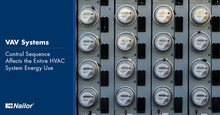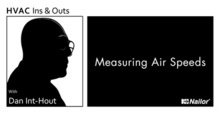Nailor Airwaves is your source for content on relevant topics concerning Nailor Industries, Inc. and the HVAC industry. New product releases, case studies, product & project spotlights, employee interviews, trade publication articles, and general announcements are some of the content types you can expect to find in the Nailor Airwaves.
Nailor Airwaves
HVAC Ins & Outs with Dan Int-Hout - Area Factors and Free Area

Every so often, we get a request for the Ak, or area factors, or for the “Free Area” for our air outlets and inlets. For many years, manufacturers published “area factors” for balancing purposes. These Ak factors are determined by measurement of indicated air velocities and measured air quantities and can be used to balance HVAC systems. For a number of reasons, these values, however, are no longer being presented. When we get these requests, the first question we must ask is “What are you going to do with the value”?
The Ak value is reported as a constant, reflecting the ratio of sensed discharge velocity to the measured air quantity. It is not based on any physical dimensional relationships. Rather, it is dependent on the type of device used to measure the discharge velocity, as well as… Read more
VAV Control: Terminal Unit Sequence Affects the Entire HVAC System

Developing real estate requires millions of decisions about what the building will look like, how to fit it within a budget, how will it operate, what HVAC system to use, etc., etc., etc. Each decision has an impact on the final product. One of these small decisions may never be consciously by the engineer designing the mechanical systems. As a junior engineer straight out of college, I was designing mechanical systems as a consulting engineer. This involved listening to the client, performing load calculations, and choosing the equipment to keep the occupants comfortable. One of the last parts of this was to import a drawing, "specs.dwg", into the drawing package that contained all the specifications for the mechanical drawings. This drawing had every spec for all equipment the firm… Read more
HVAC Ins & Outs with Dan Int-Hout - What is wrong with ADPI?

The Air Diffusion Performance Index (ADPI) was developed at Kansas State University in the 1960’s as an ASHRAE project to assist in understanding air diffuser layout and performance. The basic concept is that the ratio of the discharge air projection, defined by the diffuser’s throw, and the separation distance between air outlets, could be used to define the resulting air mixing in a space. The percentage of points in the “occupied zone” in a space that meet a criterion for acceptable “draft temperature” determined the ADPI. An ADPI of 80% was determined to be a minimum acceptable value for most of the occupants in a space, with certain assumptions regarding the uniformity of activity and clothing levels of the occupants.
The draft temperature was… Read more
VAV Systems: Ground Control to Major Tom

Choosing the right equipment for your VAV system is critical, but it is only part of creating the right solution. The specified control sequences for each terminal unit will ultimately have the largest impact on eliminating any SPACE ODDITIES. ASHRAE has issued standard control sequences for terminal units in Guideline 36: High-Performance Sequences of Operation for HVAC Systems. The goal of the guideline is to provide uniform sequences the industry can use to optimize HVAC system performance. The selection of control sequence for each piece of equipment affects the overall performance of the system.
Air Handling Unit (AHU) Control
AHUs in VAV systems are controlled using Trim and Respond control logic. A static pressure sensor in the primary ductwork that monitors pressure delivered to… Read more
HVAC Ins & Outs with Dan Int-Hout - Measuring Air Speeds

The 1962 Air Diffusion Council Test Code 1062 required that room airspeed measurements be taken with an Anemotherm Air Meter. This was a battery-powered analog highly shielded hot wire anemometer, made by Reeves Hoffman, a sister company to Anemostat, located in Scranton Pa. It was the required instrument in the ADC 1062 test code, which was ”the bible” for air outlet measurements. It was also the most popular and most readily available instrument for many years. It was, however, not without issues.
The Anemothern sensor was a wand about ½” in diameter with a couple of looped shielded wires located behind a couple of holes in a tube. In an evaluation conducted as part of the Owens Corning Fiberglas response to a GSA lawsuit on measured air motion in a GSA construction project (which… Read more